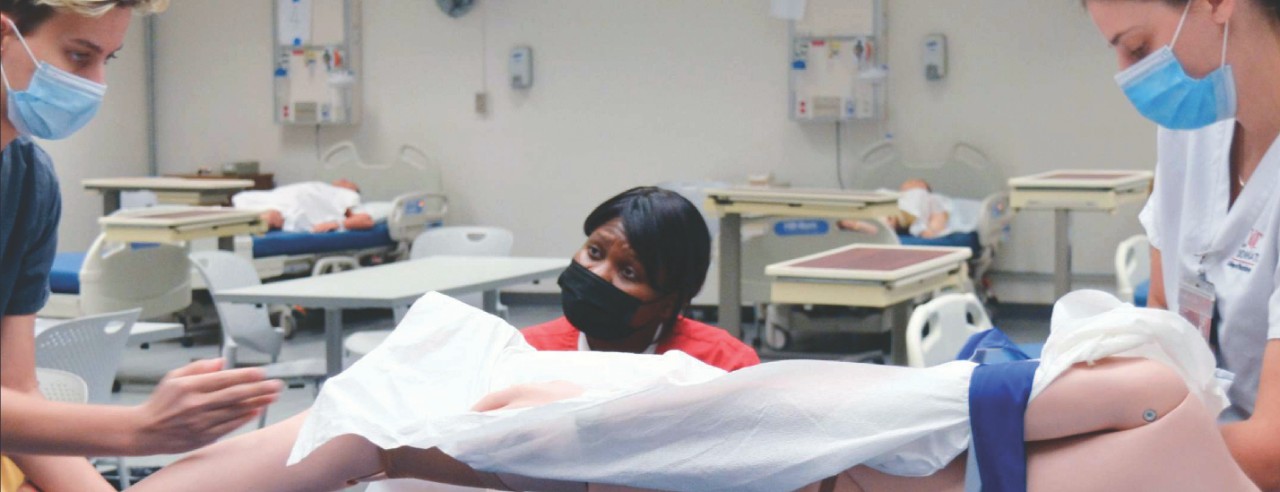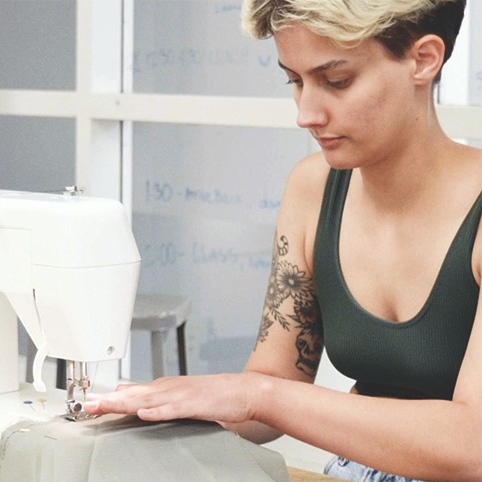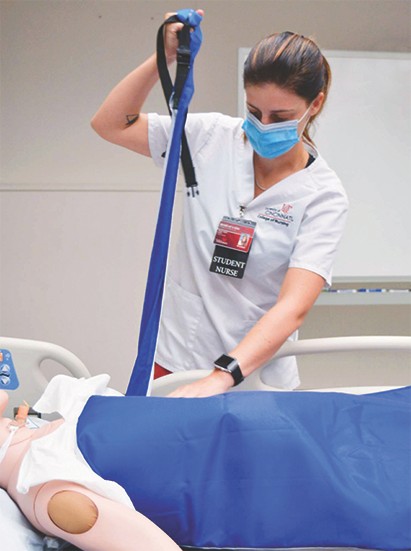
COVID meets creative clinical
Nursing and design students teamed up to tackle some of COVID-19's persistent challenges
Put together teams of nursing and design students and you'll get creative, real-world solutions to some of health care's most pressing problems, such as ongoing challenges related to COVID-19.
That's what happened when UC students in the College of Nursing's Accelerated Direct-Entry Master of Science in Nursing (MSN) program collaborated with undergraduate industrial design students in the College of Design, Architecture, Art and Planning (DAAP) to develop products or processes that tackle COVID-induced issues.
The results ranged from educational interventions for young at-home learners with ADHD to retractable shades meant to prevent virus transmission on airplanes to self-cleaning playground equipment to an online support network for overwhelmed nurses.

DAAP student Ellie Cassedy sews a prototype for her team to test. Photo/Submitted
Nursing students Precious Sims and Megan Cabell worked with industrial design students Kathleen Meyer and Ellie Cassedy during the Summer 2021 semester to find an innovative solution to a problem related to COVID deaths, their assigned
sub-topic. Initially, Sims and Cabell talked to hospital and funeral home staff about their processes to find persistent problems, or "pain points."
"For post-mortem care, you're cleaning them
from front to back, putting them in a body bag,
putting on the toe tag. It can take 30 – 45 minutes
and the hardest part is actually turning the patients," Sims says. With staff shortages
exacerbated by COVID, pulling nurses away
from other patients to help rotate and hold a patient in place for post-mortem care causes a ripple effect. "Everyone gets behind."
Sims and her teammates solved this issue by creating an apron with straps that helps nurses safely rotate deceased patients for post-mortem care. Leveraging the hospital bed rails, the product allows a single care provider to do the heavy lifting. Meyer and Cassedy created a prototype and the team tested it in the College of Nursing's simulation laboratory with four users who provided feedback that informed the final concept.

Nursing student Megan Cabell tests a version of the team's invention in the College of Nursing's simulation lab.
Sims credits her team's chemistry for the project's success.
"We had a really good group," she says. "We had design students who were very open to feedback and input. If they came up with something and Megan and I said it's not feasible because of something we deal with in the hospital, they would
change it. They really valued the input we provided, and it was important to everyone that we made a product that would benefit nurses in the long run."
The interprofessional partnership between
nursing and design students, known as the Design
+ Nursing Collaborative, started in 2008 and has evolved under Steven Doehler, MA, associate professor of industrial design, and Jeanine
Goodin, DNP, APRN, CNP, CNRN, associate professor of clinical nursing. Currently, the collaborative is offered every other year to accelerated MSN students in the Accelerated Population, Public & Community Health Nursing course as an option for their required clinical experience.
"I tell students that if you want to learn to think differently, learn a different skillset, have an opportunity to have an interprofessional experience and collaborate with a designer, then you should sign up," Goodin says.
Goodin and Doehler have developed a pedagogy for the collaborative, called "Touch-and-Go Collaboration," which fosters teamwork, but also allows for discipline-specific breakout sessions through five project phases. About a year before the semester starts, Goodin and Doehler meet to choose a focus for the next student cohort. In 2020, the pair received a $15,000 UC Forward grant to focus on COVID, which, Doehler says, presented a unique topic for its ubiquity.
"It was right at our fingertips," he says. "We were seeing it every day. We were
living it. We've never had a topic that was so global and where we were all in it. The
information was changing constantly, and everyone was learning how to be agile
inside of it."
Goodin calls the collaborative a win-win for nursing and design students. "Their
contributions and interaction can be very powerful," she says. Some final designs
have led to employment or commercialization offers.
We've never had a topic that was so global and where we were all in it. The information was changing constantly, and everyone was learning how to be agile in it.
Steven Doehler, MA Associate Professor of Industrial Design
Other Group Projects
Teams were assigned a sub-topic for their COVID-related projects. In addition to COVID deaths, student teams created innovative solutions in these areas:
Air Travel
Created two retractable shades — one for the headrest between rows and another for between seats — to help prevent airborne virus transmission.
Bars and Restaurants
Designed a QR code for tables and a process for customers to scan the code, access the menu, place their order, notify a server when needed and pay their bill; the product and process also included a staff training plan for use.
COVID-19 Vaccine
Developed an educational video for vaccine-hesitant population to boost vaccination rates, addressing vaccination barriers and explaining how vaccines work.
Grade School
Focused on at-home learning needs of children with ADHD, including engagement and support for students, teachers and parents.
Nurse Protection
Created a social support network and tele-support system for nurses to share and interact with other nurses in a safe environment.
Outdoor School Playground
Developed a playground designed to promote social distancing and some individual self-play among children; equipment included a self-cleaning mechanism.
Related Stories
PHOTOS: 2025 DAAP Fashion Show
May 9, 2025
Over 900 people attended DAAPFASH25, a fashion show that highlights the collections of the fashion design Class of 2025. The show is now in its 72nd year.
UC lab-on-a-chip devices take public health into home
May 8, 2025
University of Cincinnati engineers created a new device to help doctors diagnose depression and anxiety. The “lab-on-a-chip” device measures the stress hormone cortisol from a patient’s saliva. Knowing if a patient has elevated stress hormones can provide useful diagnostic information even if patients do not report feelings of anxiety, stress or depression in a standard mental health questionnaire.
University of Cincinnati announces new leader for prestigious...
May 8, 2025
The University of Cincinnati names Stephanie Pilat, PhD, as the eighth dean of the renowned College of Design, Architecture, Art, and Planning beginning July 1, 2025.
